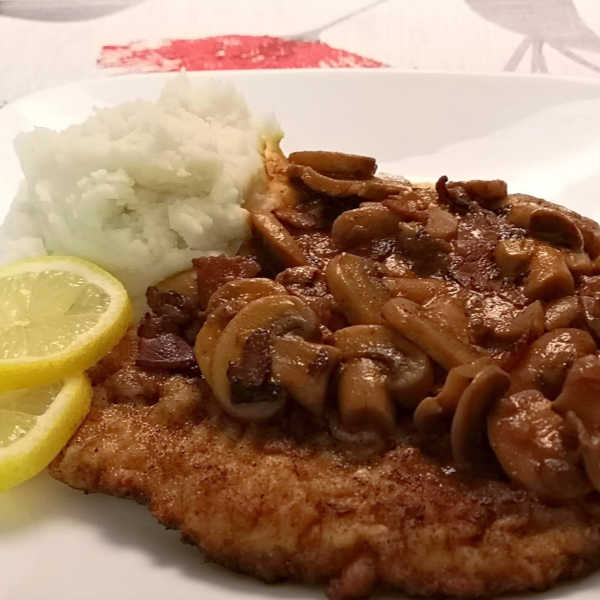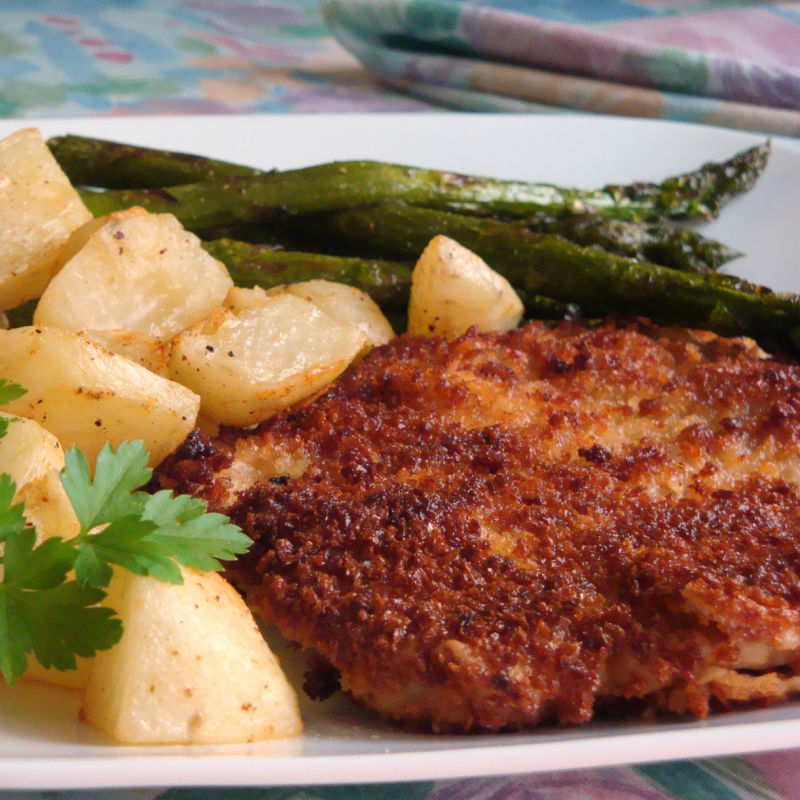- Home
- German Food Guide
- What is Schnitzel?
What is Schnitzel? & How to Make This Easy German Pork
Recipe
By: Gerhild Fulson / Using her extensive experience and cultural knowledge, Oma Gerhild provides trusted, authentic, and easy-to-follow German recipes both here and in her many cookbooks.
Schnitzel is such a traditional dish in Germany that it comes as a surprise to me that not everyone knows the answer to “What is Schnitzel?”. My first answer is that it's delicious. My second answer is … well, it's actually a bit more complicated.
I'm going to peel back the layers of this most delicious dish, immerse ourselves in its history, and explore the many types of schnitzels that are cooked in the different regions of Germany. The end result? Lecker schmecker delicious!
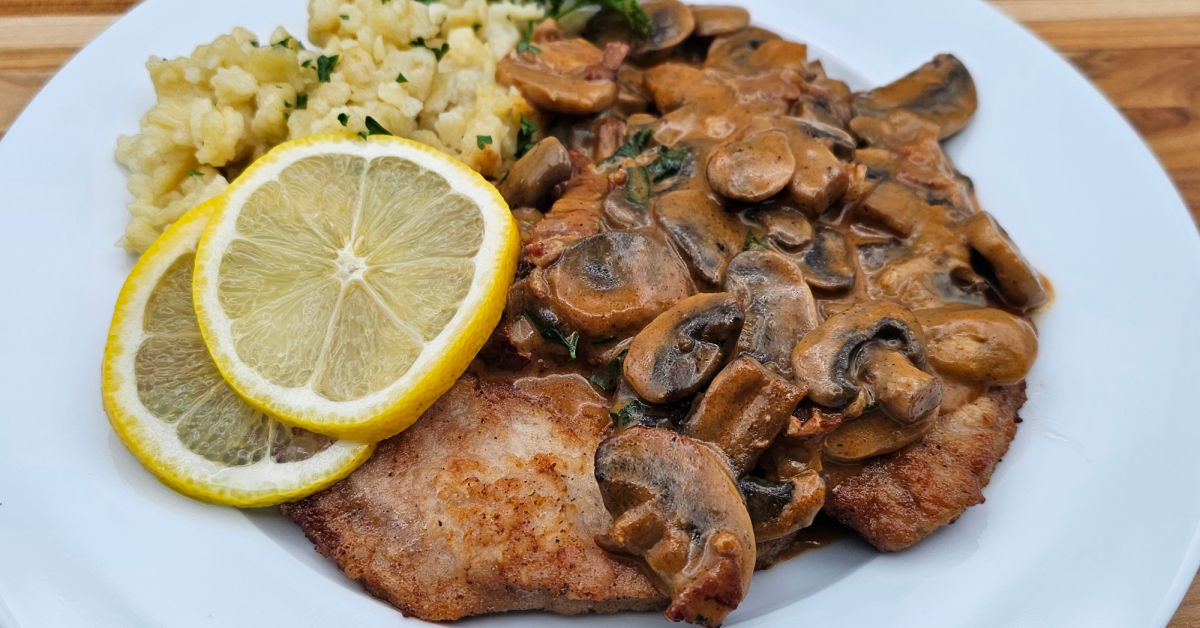 Jägerschnitzel with non-breaded pork and mushroom bacon gravy.
Jägerschnitzel with non-breaded pork and mushroom bacon gravy.But before I take a bite into history, a quick definition of schnitzel is needed.
What is Schnitzel?
Schnitzel:
a thin slice of meat, usually tenderized by pounding, coated in flour, eggs,
and breadcrumbs, and then pan-fried until perfectly crispy with a deep golden
brown crispy breading that covers the tender, juicy meat.
The
History of Schnitzel: Roman? Italian? Austrian? German?
The
Roman Influence:
Sometime between the 1st and 5th centuries AD, Of Culinary Matters (originally, De Re Coquinaria) was written and is considered to be the first recorded cookbook that is still in print today. Most assume Marcus Gavius Apicius, a Roman gourmet who lived sometime in the 1st century AD during the reign of Tiberius, wrote or compiled it.
Within the many techniques given, there are three that match schnitzel: pounding meat to tenderize, coating with bread crumbs, and frying.
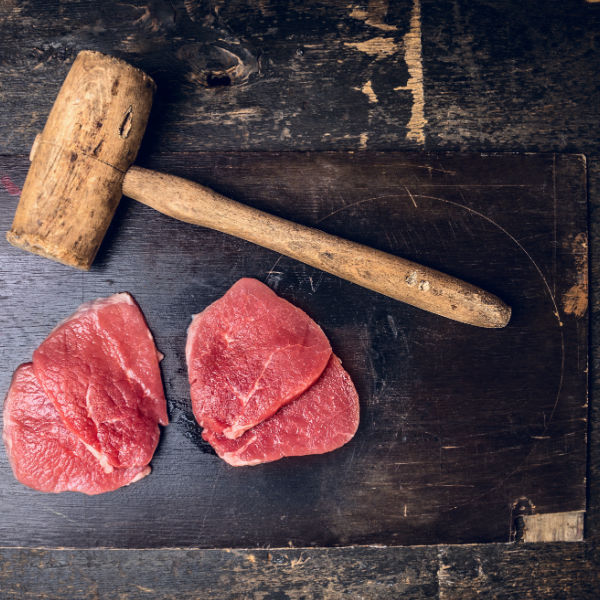 Pounding meat to tenderize has been done for ages.
Pounding meat to tenderize has been done for ages.This suggests that our modern schnitzels have been around for over 2,000 years.
From 12 BC to 16 AD, the Romans traveled to the Germanic countries, the land bordered by the Vistula R. on the east, the Rhine R. on the west, southern Scandinavia on the north, and the upper Danube R. on the south. I think one can assume their cooking methods came with them and is the start of answering the question, What is Schnitzel?
The
Italian Influence:
Fast-forward to the Middle Ages, when veal was widely eaten in northern Italy, and then later, in the Renaissance period, Cotoletta alla Milanese is mentioned in cookbooks in the early 17th century. Just what is Cotoletta alla Milanese? A tender veal cutlet coated in crunchy breadcrumbs and fried in butter, usually still with a bone.
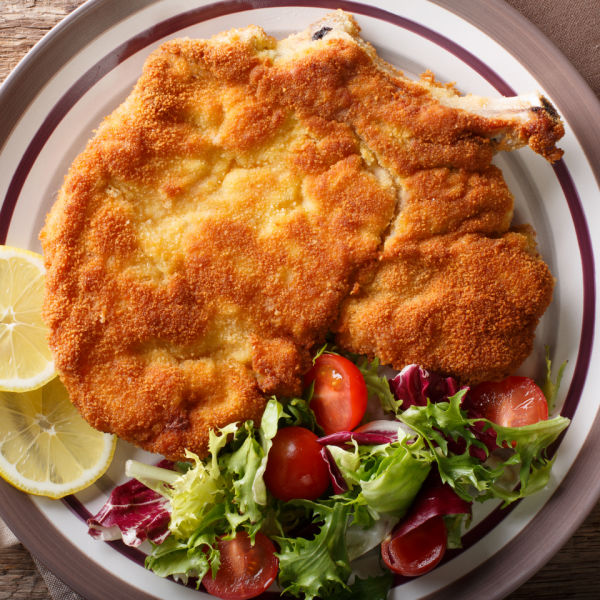 Veal Milanese (Cotoletta Alla Milanese) with lemon. Not boneless!
Veal Milanese (Cotoletta Alla Milanese) with lemon. Not boneless!Ummm, that almost sounds like a fat schnitzel, aka breaded cutlet.
The
Austrian Influence:
Fast-forward again, this time to the 1850's and Radetzky, the Austrian field marshal stationed in Northern Italy, was so impressed with that Cotoletta alla Milanese that he brought it back home to Austria. A little pounding of the meat, and the Austrian Wiener Schnitzel was born.
Aha. The answer to, What is Schnitzel!
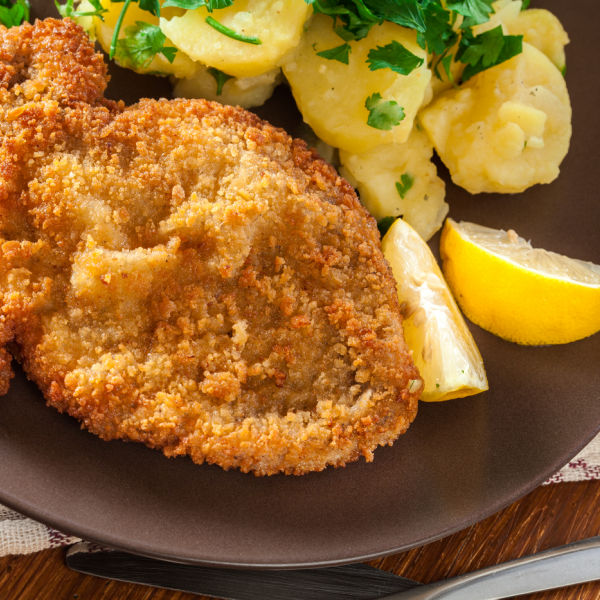 Wiener Schnitzel with lemon and boiled potatoes. Of course, made with veal!
Wiener Schnitzel with lemon and boiled potatoes. Of course, made with veal!This is considered by many to be the beginning of the history of the Schnitzel, claiming Austria as its origin. And by Austrian law and trademarks, for a schnitzel to be called a Wiener Schnitzel or Viennese Schnitzel, it must be made from veal. Only veal.
The
German Influence:
The German word schnitzel (Middle High German: snitzel) is a diminutive of sniz meaning 'slice'. The name Wiener Schnitzel is first seen in printed in this book: "Rheinische Jahrbücher zur gesellschaftlichen Reform", by Püttmann, Hermann, Publication date: 1845.
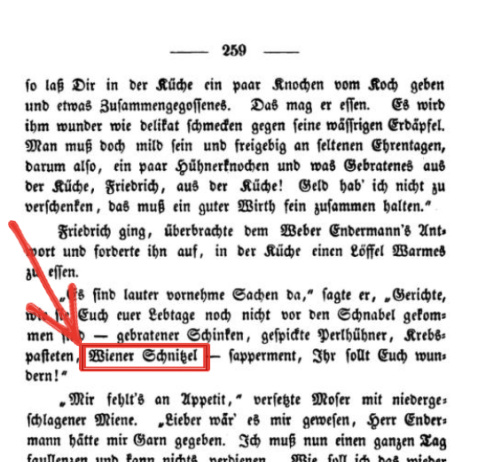 If you can read old German, you'll see Wiener Schnitzel printed in the highlighted box.
If you can read old German, you'll see Wiener Schnitzel printed in the highlighted box.What?
This was published in 1845? Before Radetzky?
That puts his contribution into question. But it does show that the actual word schnitzel is of German origin. The Viennese schnitzel connection really remains unknown. And so the controversy continues. Can schnitzel really be called a German recipe? Well, linguistically, the word IS German.
Even if the origins of schnitzel can't be pinned down with accuracy, its place in the culinary history of Germany is established. German cooks have put their own twists on the dish, creating many versions.
The use of different types of meat, such as chicken, veal, beef, mutton, pork, turkey, and even venison, and then the variety of sauces and combinations of sides, provide a type of schnitzel to suit regional palates.
Austrians have a culinary law: Never ever put a sauce on top of a breaded schnitzel! That's a BIG no-no.
For example, Jägerschnitzel in Austria is a plain piece of fried veal covered with sauce as shown at the very top of this article.
Germans, however, don't mind having a mouthwatering creamy mushroom sauce cover that perfectly breaded and fried piece of meat. (I'm in that camp! But then, I'm German.)
Types
of Schnitzel
With so many varieties to choose from, here are the top 10:
- Wienerschnitzel - Wiener schnitzel (must be veal)
- Schnitzel Natur - non-breaded schnitzel
- Jägerschnitzel - hunter's schnitzel (breaded or non-breaded schnitzel with dark creamy mushroom sauce, with or without bacon)
- Rahmschnitzel - schnitzel with a creamy sauce (with or without mushrooms)
- Paprikaschnitzel (aka Zigeunerschnitzel) - paprika schnitzel (breaded schnitzel with a sauce from tomatoes, roasted onion, and bell pepper)
- Bierschnitzel - beer schnitzel (non-breaded schnitzel, covered with a beer sauce, topped with cheese and oven baked)
- Frankfurterschnitzel - breaded schnitzel served with Frankfurter Green Sauce
- Zwiebelschnitzel - non-breaded schnitzel and baked in an onion, cream and wine sauce topped with cheese
- Holsteinschnitzel - Holstein-style schnitzel (breaded schnitzel served with a fried egg, anchovies, and a lemon-caper sauce)
- Münchner Schnitzel - Munich-style schnitzel (schnitzel brushed with horseradish and sweet mustard before breading)
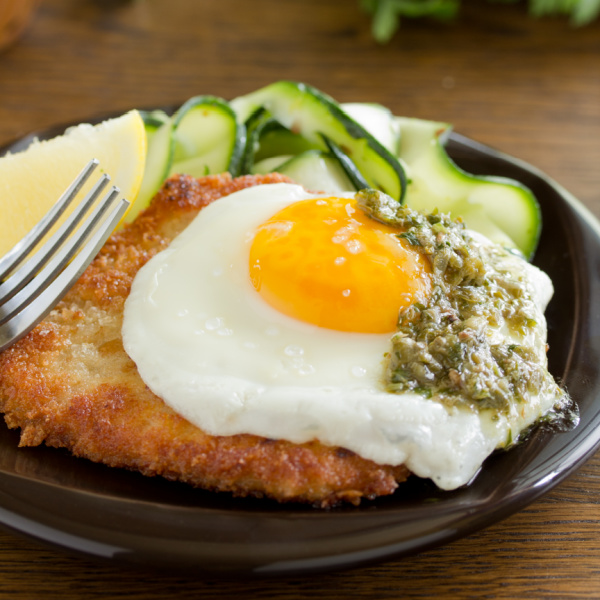 Holstien Schnitzel with fried egg and caper sauce.
Holstien Schnitzel with fried egg and caper sauce.Pair
your Schnitzel:
Although schnitzel will pair with almost anything, there are several side dishes that stand out as the most popular sides for that perfect schnitzel. The most popular choice? Pomme Frites!
- a lemon wedge or slice
- Kartoffelsalad NG* (German potato salad)
- Kartoffelsalad SG* (German potato salad)
- Spätzle (egg noodles)
- Gurkensalat NG (cucumber salad)
- Gurkensalat SG (cucumber salad)
- Pommes Frites (French fries)
- Bratkartoffeln (fried potatoes)
- Schnitzelbrötchen - Serve breaded schnitzel on a crispy German bun with mustard, mayo, ketchup, lettuce and pickle slices
*NG: Northern German style (with cream/mayo)
*SG: Southern German style (without cream/mayo)
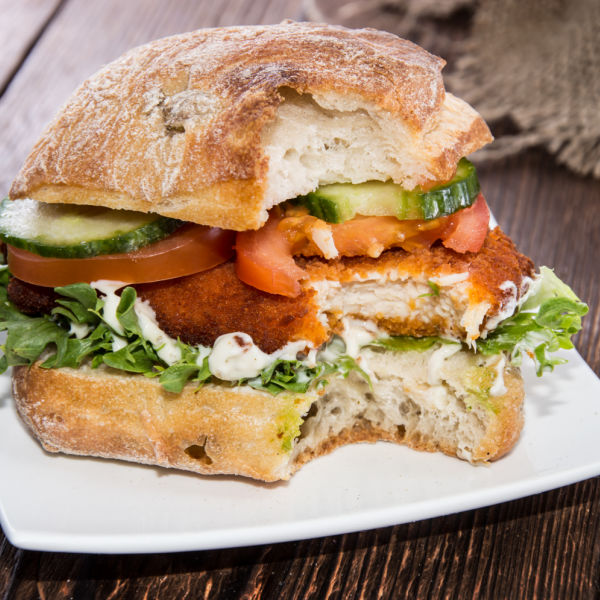 Schnitzel Brötchen: Schnitzel on a loaded bun. Yum!
Schnitzel Brötchen: Schnitzel on a loaded bun. Yum!1-2-3
Basics of an Authentic German Schnitzel Recipe:
If you have a craving for that authentic taste of Germany, here's a quick overview of how to make a great pork schnitzel, the most popular kind that's served in Germany. This same recipe will work for almost any type of meat, such as chicken breast or chicken cutlets, sliced turkey breast, or veal meat, almost any thin piece of meat.
Get my authentic German Schnitzel recipe with a step-by-step guide to making that tender, juicy schnitzel with that crispy golden-brown crust.
The recipe uses boneless pork chops or pork cutlets. I butterfly them and then pound them thin with the flat side of a meat mallet. This works best if the meat is placed between sheets of plastic wrap.
- The easiest way to make schnitzel is to set up an assembly line. Set out three shallow plates. Into the first one, add flour that’s seasoned with salt and black pepper. Into the next, make an egg wash (egg mixed with water). Into the last one, add your regular or Panko breadcrumbs.
- Dredge the meat first into the flour, then into the egg mixture, and then into the breadcrumbs.
- Place a large skillet over medium-high heat on the stove and add a butter/oil mixture. When hot, fry the schnitzel (without crowding them in the skillet), about 3 minutes on each side, until crispy. Drain and serve.
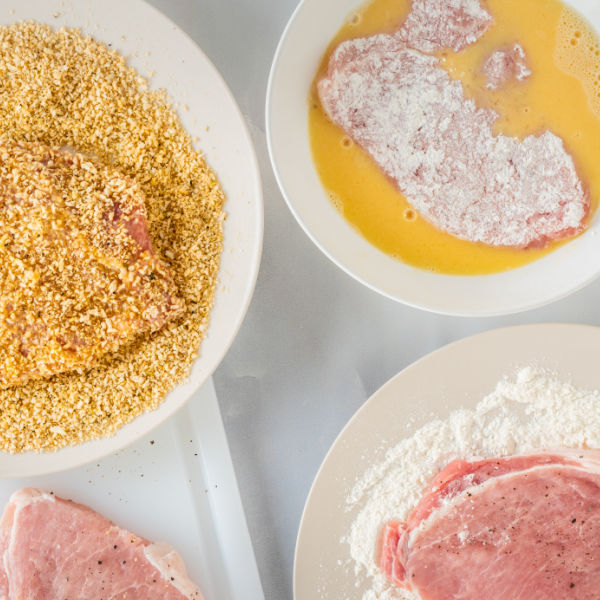 Making schnitzel with an assembly line. So easy!
Making schnitzel with an assembly line. So easy!Follow these three easy steps, and you'll be enjoying the best pork schnitzel for dinner tonight.
To see my complete printable recipe, click here.
Schnitzel is more than just a meal. It's that little bit of German culture that starts with simple ingredients and transforms them into a mouth-watering dish that's been made with love.
Guten Appetit und Tschüß
We’ve peeled back those layers to answer that question, What is schnitzel?
We’ve looked at the unusual history and seen the regional differences within Germany. More than just a mere dish, schnitzel is a slice of German culture, where simple ingredients are lovingly transformed into a mouthwatering dish.
Next time you savor that perfectly cooked schnitzel (with Jägersosse?), remember that it’s more than a meal. It’s a delicious taste of German tradition.
Let's Learn German
Guten Appetit: Enjoy your meal
Tschüß: Bye-bye

